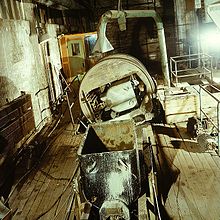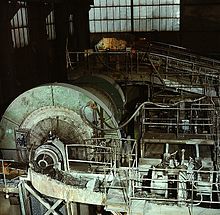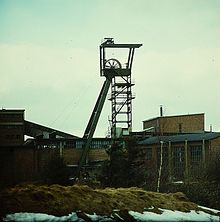Three crowns & honor
| Three crowns & honor | |||
|---|---|---|---|
| General information about the mine | |||
| The mouth hole of the upper Mühlental tunnel. | |||
| other names | Pit of Heavenly Lord, Pit of Unity | ||
| Mining technology | Civil engineering | ||
| Funding / year | 381,144 (1973) t | ||
| Funding / total | 13,000,000 t of pyrite | ||
| Information about the mining company | |||
| Operating company | VEB Bergbau- und Hüttenkombinat Freiberg | ||
| Employees | 116 (1990) | ||
| Start of operation | 1530 | ||
| End of operation | July 31, 1990 | ||
| Funded raw materials | |||
| Degradation of | Iron / pyrite / manganese | ||
| Greatest depth | 560 m | ||
| Degradation of | Pyrite | ||
| Degradation of | manganese | ||
| Geographical location | |||
| Coordinates | 51 ° 45 '50.2 " N , 10 ° 49' 33.1" E | ||
|
|||
| Location | Elbingerode (Harz) | ||
| local community | Upper Harz on the Brocken | ||
| District ( NUTS3 ) | resin | ||
| country | State of Saxony-Anhalt | ||
| Country | Germany | ||

Drei Kronen & Ehrt in the Harz mining region is a former mine in Elbingerode in the Harz district ( Saxony-Anhalt ), in which pebbles ( pyrite ) were extracted. The hydrothermal mineralization is bound to the Devonian reef limestone of the Elbingerode complex . From 1992 to 2015 it was used as a visitor mine with interruptions .
geography
location
The mine is located in the Lower Harz between Elbingerode and Rübeland (both in Upper Harz am Brocken ) on federal road 27 . It is located on the northeast flank of the Bodenberg ( 491.1 m above sea level ) at about 445 m above sea level. NHN . The open- cast limestone mine of Fels-Werke extends north of the road in the direction of the Galgenberg . The route of the Rübelandbahn runs directly past the factory premises, parallel to the B 27, from which a track branches off to the aforementioned Fels factory.
history
Iron stone mining from the Middle Ages to the 19th century
In the vicinity of today's pit, iron stone was already mined in historical times . A Himmelsfürst mine was first mentioned in a document in 1530. The Großer Graben open-cast mine, first mentioned in 1582, was operated in the immediate vicinity of today's visitor mine . In the middle of the 19th century, mining reached a depth of around 40 meters. The previously natural drainage was no longer possible and the water was pumped out using hand pumps . From 1867 to 1871, the Count zu Stolberg-Wernigerode had what is known as the Count's Gallery , which carried away the water . When driving the tunnel , a previously unknown pyrite deposit was found that was not initially mined. In order to be able to better transport the iron ore from the Großer Graben , a second tunnel, the Upper Mühlental tunnel, was built between 1887 and 1889, seven meters above . It led to the lowest point of the open pit. In 1890, after the Count was raised to the rank of Prince, the Count's gallery was renamed the Princely Gallery .
Pebbles mining from 1890 to 1927
From the beginning of the 1890s, pyrites were also mined, initially in small quantities. The emerging chemical industry took pyrite as a raw material for sulfuric acid . 20,000 tons had been sold by 1901. In 1903, pebbles were temporarily stopped, as cheaper foreign ores drove out the local ones. A period of inconsistent funding followed. With the beginning of the First World War , the production increased again. All ore fields in the vicinity of the Great Grave now traded as Drei Kronen and Ehrt . The term Drei Kronen stood for the ore mines, the name Ehrt for the sulfur gravel field.
During the Great Depression in the 1920s, production was stopped. An existing cable car for the Großer Graben was decommissioned in 1921 and dismantled in 1922. In 1926 the opencast mine was stopped because the deposit was exhausted . Until 1927, iron stone was mined underground by 25 miners and a Steiger .
In the time of National Socialism
In the course of the armament of Germany in the run-up to the Second World War , funding was resumed in 1935, supported by a state funding program. The main shaft reached a depth of 82.5 meters in 1938. In addition to iron ore and manganese as an additive for steel production, pyrite was also mined. During this period, an extensive exploration was carried out in the vicinity of the mine, through which further pyrite deposits and poor ores were found.
In 1943 333 people were employed in the mine. Most of them were forced or foreign workers. In addition to 76 German miners, 149 people from the Soviet Union , 74 Italians , 17 Poles , 10 Czechs and 7 Belgians worked at Drei Kronen & Ehrt . The foreign workers were housed in three barracks on the factory premises.
The production was increased to up to 8,200 tons of pyrite per month, which, however, mostly did not reach the target figures. Due to the deterioration in supply towards the end of the Second World War, production declined again from 1944 onwards. In February 1945 only 200 tons of manganese ore and 2,230 tons of pyrites were extracted. The last regular shift was on April 13, 1945. Allied troops had been only 10 kilometers away for two days. Emergency work was carried out until April 18. That day the power went out, so the pumps failed. US troops occupied the mine area without a fight. They searched the surface area on April 21st, and then withdrew. There was looting and destruction, mainly by forced and foreign workers who remained in the region. The production documents from before 1945 were largely lost.
It is assumed that in June 1945 the pit had sunk to its natural outlet over the Princely Gallery . Funding could therefore not be resumed for the time being, although there were urgent inquiries, for example from the Central German cell wool . One made do with poverty that was still on the dump. Through expropriation without compensation, Drei Kronen & Ehrt became the property of the Province of Saxony . After a few weeks, pyrite extraction was resumed, initially only on the tunnel floor, and from December 1946 also from the 77-meter floor.
Post-war period until closure, 1945–1990

On January 1, 1951, the facility was renamed the pit unit . The name stood for the German unity that the GDR was still striving for at that time . Although this goal was later no longer part of the raison d'etat , the name remained. The pyrite deposit was the only one in the entire area of the GDR and covered 30% of the GDR's sulfur requirements . The annual production rose to up to 150,000 tons. In 1964 the good lots were mined and one had to fall back on ore with a lower sulfur content. Instead of 40 to 45% sulfur, the ore now only had 21% sulfur. These ores could no longer be processed economically with the fluidized bed process used until then . In preparation for this situation, people had been looking for new ways of processing the ore since 1957. Efforts were also made to find new deposits. Both were ultimately successful, so that large-scale investments were made in the mine facilities.
A mine water treatment plant was built , a boiler house fired with raw lignite and a new administration building with a chow . In addition to a reconstruction of the mine, the new shaft, which was sunk in 1959, deserves special mention. It led down to the 15th level at a depth of 460 meters and thus opened up a further 80 meters. Three older shafts were replaced in this way. A processing plant with crushers and a flotation plant was built above ground . In addition, a stacking hall and rail loading were built. In 1965, 515 people were employed at the mine.
Thanks to the new processing technology, it was now possible to increase the sulfur content to 42%, but the grain size was well below one millimeter , which various previously declining companies could not work with. About 95% of the production was delivered to the sulfuric acid factory of the VEB Bergbau- und Hüttenkombinates Freiberg . The largest amount of sulfur was produced in 1971 with 56,559 tons. Raw ore production reached its maximum of 381,144 tons in 1973. In the following years the quantities fell continuously. Since 1978 the GDR has been increasingly importing elemental sulfur from Poland. In 1989, the last full production year, 237,000 tons of ore with 30,500 tons of sulfur were extracted. The number of employees had already fallen to 427 employees during the GDR era. With the use of more modern mining equipment, the mine achieved an ore extraction of 50 tons per man and shift, which is also remarkable internationally - in relation to the amount of raw ore.
With the political turning point in 1989 it became clear that the costs of sulfur production were far too high in an international comparison. The pit now belonged to the Treuhandanstalt . Harzbergbau GmbH Elbingerode was founded on May 1, 1990 through a partnership agreement . However, the company was dependent on allocations from the Treuhandanstalt. Missing payments led to difficulties in paying wages, so that a loan had to be taken out. Initially, production was to be discontinued in 1991, but production was brought forward to July 31, 1990. The last tram was then symbolically promoted on December 4, 1990, St. Barbara's Day . The exit of the specially decorated trolley attracted little attention from the 116 employees at the time. A total of around 13 million tons of ore was mined.
Visitor mine 1992–2009 and 2011–2015
The first idea of making parts of the mine , which was still in operation as a state- owned sulfur gravel pit unit, also available to the public at that time, already existed at the beginning of 1989. The technical manager of the mine suggested making the first floor of the plant accessible to visitors. However, the idea did not materialize.
As early as February 1990, seven miners founded the Drei Kronen & Ehrt eV visitor mine . The number of members rose to 45 by 2001. In 1990, a job creation measure was approved in which 21 former employees worked on setting up the visitor mine. Buildings required for the show mine were renovated, others demolished. Suitable machines were transported from the lower levels into the show area. New tracks were laid, old routes were made passable and lighting was installed. Hunte were converted for passenger transport.
The first opportunity to visit was on May 22, 1992, limited tours were held from July 1993. The visitor mine was opened on July 1, 1994. The job creation measures expired at the same time, there were now 13, later only 9 permanent employees working for the visitor mine. The environment was upgraded with subsidies, so the depot could be paved. The number of visitors rose from 21,000 in 1994 to 35,000 in 2001. In 2009, the visitor mine was closed. The display part of the mine was leased to an employment promotion company. The visitor mine reopened on December 19, 2011.
The visitor mine finally closed on November 1, 2015. The underground equipment was completely dismantled. Following that was keeping the still accessible parts of the first sole and the visitor mine made to prevent leakage of the mining affected water from the mine. The closure and the subsequent safekeeping are intended to avoid the perpetual costs borne by the federal government .
The Gräfliche or Princely Gallery marked the beginning of the visitor mine , the Obere Mühlental gallery has served as the entrance to the visitor mine since 1993.
In the summer of 2015, the visitor mine served as one of the locations for the film Bad Weather - The Secret of the Past .
Drei Kronen und Ehrt was included as No. 61 in the system of stamping points of the Harz hiking pin until 2016 . The stamping point was a few meters southeast of the entrance gate ( ⊙ ) of the visitor mine.
literature
- Horst Scheffler : The Elbingerode visitor mine "Drei Kronen & Ehrt" . Ed .: Friends of the visitor mine “Drei Kronen & Ehrt” eV Elbingerode. Self-published, Elbingerode 2002, DNB 1067080597 .
- Author community: Grube Einheit: Goldener Schatz im Harz . Ed .: Wolfgang Schilling. Self-published, Blankenburg 2016, ISBN 978-3-935971-85-0 .
- Horst Scheffler, Friedhart Knolle: The "Unity" pit near Elbingerode . In: Sachsen-Anhalt-Journal 27 (2017), no. 2, pp. 13–15.
Web links
- The crevice and chute calcites of the VHMS deposit Elbingeröder complex near Elbingerode in the Harz / Saxony Anhalt in Germany. Retrieved February 8, 2012 .
- official pages of the visitor mine
- Mineralienatlas - pit unit (three crowns and honor). Retrieved June 26, 2014 .
- Klaus Stedingk: The potential of ores and spades in Saxony-Anhalt. (PDF 4.82 MB) In: Communications on the geology and mining of Saxony-Anhalt, supplement 5 (2002) Raw materials report 2002: Distribution, extraction and safeguarding of mineral raw materials in Saxony-Anhalt. LAGB, 2002, archived from the original ; Retrieved March 21, 2010 .
- Drei Kronen & Ehrt - visitor mine in Elbingerode in the Harz district. Retrieved August 1, 2015 .
Individual evidence
- ↑ Saxony-Anhalt Viewer
- ↑ a b Horst Scheffler: The Elbingerode visitor mine "Drei Kronen & Ehrt" . Elbingerode 2002, p. 20 .
- ↑ Horst Scheffler: The Elbingerode visitor mine "Drei Kronen & Ehrt" . Elbingerode 2002, p. 23 .
- ↑ Hammer blows on the trousers and "Drive free!" Into the visitor mine. In: Volksstimme . December 11, 2011, accessed February 13, 2017 .
- ↑ Visitor mine is threatened. In: volksstimme.de. Retrieved July 9, 2015 .
- ^ Written questions with the answers received from the Federal Government in the week of February 23, 2015. (pdf) In: Drucksache 18/4140. German Bundestag 18th electoral term, February 27, 2015, accessed on July 9, 2015 .
- ↑ Wolfgang Schilling: Layer in the shaft. In: Mitteldeutsche Zeitung. October 26, 2015, accessed January 16, 2016 .
- ↑ Changed stamp locations since April 16, 2016. harzer-wandernadel.de, accessed on February 13, 2017 .





